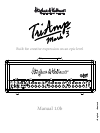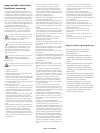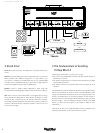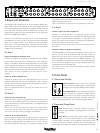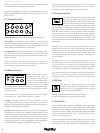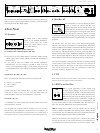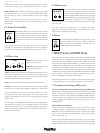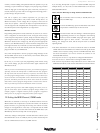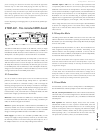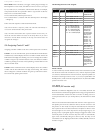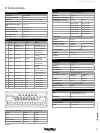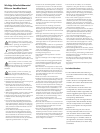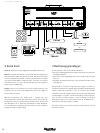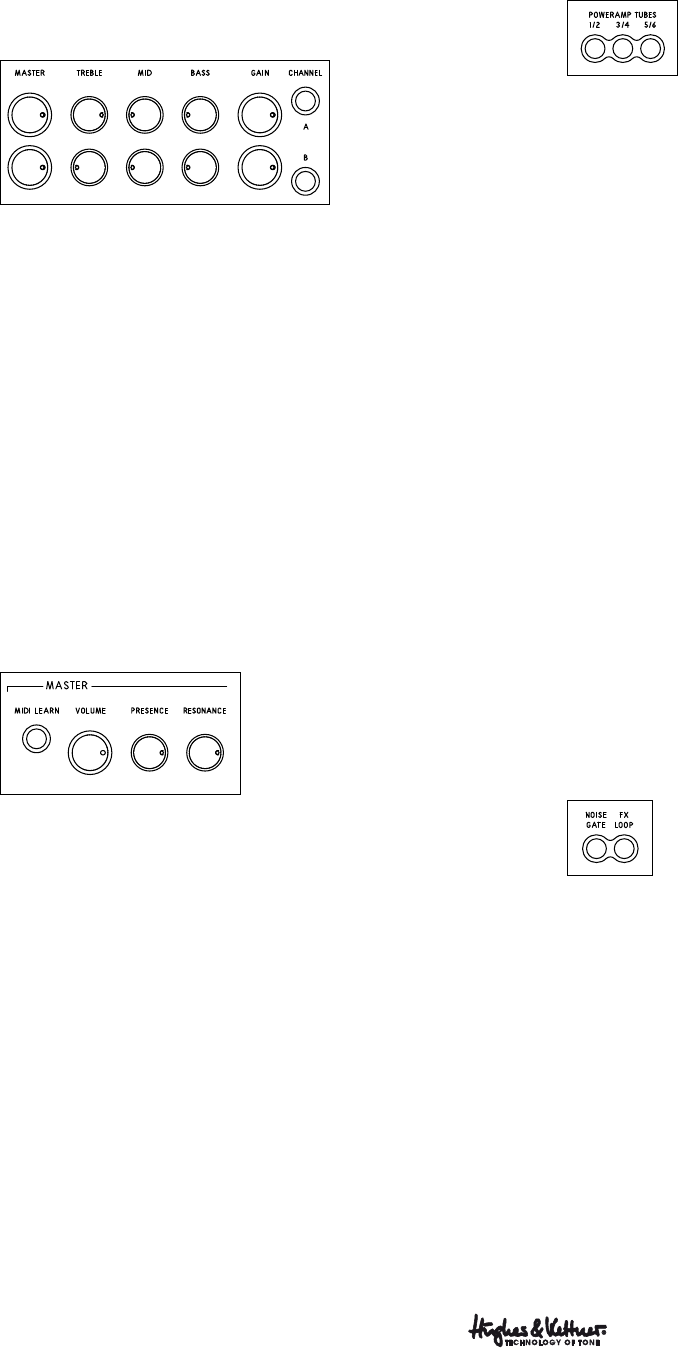
6
TriAmp Mark 3 – Manual 1.0b
Mark 3, and is tailored to each channel’s character, meaning that it works
like six different external solid state stomp boosters.
Clever fact: The Stomp Boost is actually a separate module located on an
additional PCB (printed circuit board) and is switched on or off via true
bypass circuitry.
5.3 Channel Controls
Channel Buttons: Push these to select the desired channel directly.
Gain, Master: Gain determines input sensitivity and therefore the
saturation level of the preamp. Paired with the Stomp Boost, Gain is your
most important sound sculpting tool. Use the separate Master controls to
adjust and match channel levels to your satisfaction!
Bass, Mid, Treble: The three-band voicing section’s sound-shaping action
is fine-tuned for each channel. The individual EQ controls specifically
address the frequency ranges that define the tonal characteristics of their
respective channel.
Heads-up: These are classic passive tone controls that influence one
another. For example, if you crank the Mid knob, the Bass knob will be
less sensitive than when you back the Mid knob down.
5.4 Master Controls
Volume: The master Volume control
determines the overall output of
your TriAmp Mark 3. This knob puts
the power of 150 tube-driven watts
between your thumb and forefinger.
Use it wisely, because it can induce
everything from bliss to pain to near madness in your band mates. Though
twisting this knob can be as much fun as the law allows, don’t unleash
all this power rashly.
Exercise restraint, turn it up gradually to a level that suits the venue and is
not harmful to your – and your fellow musicians’ – hearing!
Presence: This knob controls the amount of harmonic overtones
generated by the power amp. The higher the setting, the more intense
the effect. Use the Presence control to dial in razor-sharp tones when you
need your musical statements cut through.
Resonance: Set the Resonance knob to 12 o’clock, and you will hear the
natural resonance created by the combination of the TriAmp Mark 3 and
your chosen cabinet(s). Twisting the Resonance control counterclockwise
dampens the speakers’ and the cabinets’ resonance for a looser, softer
sound. Turning the control clockwise intensifies resonance for a tighter,
punchier low end. Turn it up fully to dig deep into the dark underbelly of
the TriAmp and draw up bowel-shaking sub bass frequencies!
Tip: The Presence and Resonance controls work well as a master EQ, and
allow you to adjust your overall sound to different cabinets or venues wit-
hout having to fiddle with the EQs of your individual channels.
5.5 Power amp Tubes
These three unimposing buttons are actually TriAmp
Mark 3’s secret weapon! They open up a whole new
chapter in the epic tale of tube-driven tone. Each of the
three pairs of power amp tubes is freely assignable to
each of the amp’s six channels – all you need to do is select your desired
channel, and then activate the pair (or pairs!) of tubes you want. Each of
the three pairs of power amp tubes can be equipped with EL34 or 6L6GC
tubes (see the TSC Chapter to learn more about TriAmp’s autobiasing
system). This allows you to mix and match the different kinds of tubes in
any of TriAmp Mark 3’s channels. And, with the use of MIDI Presets, you
can even play the same channel with different power amp tubes at a tap
of a button on the footswitch. (See the MIDI Chapter to learn more about
MIDI Presets).
This lets you do some pretty exotic stuff with TriAmp Mark 3! For
example, over the course of one song you can play lead with one pair of
6L6s at 50 watts (for the intro), add a second pair of 6L6s (at 100 watts)
for riffing, and, instead of using the Boost, kick in the EL34 tubes to add
some creamy midrange punch (at up to 150 watts) for your solo! Trust us:
you will be heard!
Or, imagine this: you can now switch from British EL34 tones to the
distinctive American 6L6 sound within the same channel via Midi. Or,
you could even go from Chinese EL34s to Slovakian EL34s without
changing tubes, or amps, or channels. Among other things, TriAmp Mark
3 genuinely is the world’s first six-channel Tube Comparison Machine!
Note: The TriAmp Mark 3 can be equipped with other types of poweramp
tubes as well: The following types have been testet in the TriAmp Mark 3
by Hughes & Kettner: KT77, KT66, KT88, 5881 WXT, 6550 A, 6CA7, 7581
5.6 FX Loop
The SmartLoop™ effects routing circuit offers parallel
and serial FX loop modes for patching in external effects
devices. Its status – on or off and parallel or serial – is stored
within each channel or MIDI Preset.
FX Loop: This button switches the effects loop on and off.
Learn more about the Effects Loop in Rear Panel chapter.
5.7 Noise Gate
The ultra-precise IDB™ (Intelligent Dual Breakpoint) noise gate gauges
levels simultaneously at two key points in the signal chain: the Input and
the preamp’s output. The IDB™ technology then uses these two values to
calculate the optimum response, and automatically adapts the standard
attack and threshold parameters for you. You’ll never hear another
extraneous noise from your amp!
The Noise Gate button switches the IDB™ noise gate on and off for each
channel or MIDI preset. When activated, the noise gate kicks in to mute
the preamp as the signal level drops below a certain threshold, removing



